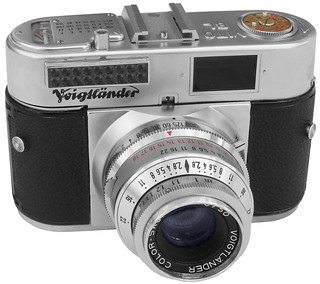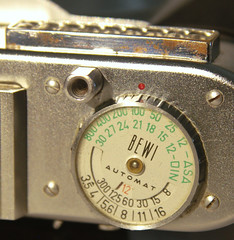Vito BL
The Voigtländer Vito BL was fixed lens camera introduced in 1956, and produced up until 1960.

|
| Vito BL with Bertram meter image by Alf Sigaro (Image rights) |
It is convenient to think of it as being a large viewfinder Vito B, with the addition of a un-coupled selenium light-meter, but the BL was introduced before that camera, so it would be more accurate to describe a Vito B as a Vito BL without a meter - except the B is 1mm taller than the BL.
In common with other Vito models, it came in many specification variations. The lens can be either a 50mm f/2.8, or f/3.5 Color-Skopar. The meter is non-coupled either a Bewi-Automat or a Bertram (both made by Ernst & Wilhelm Bertram), and there are significant differences between the two meters. There were even viewfinder variations (with or without a bright-line). The one consistent feature appears to be a 9 speed (300-1s plus B) Prontor SVS shutter (but very late models may have been fitted with a different shutter)
The Bertram meter has no provision for sensitivity adjustment according to film speed. Instead the EV scale is changed via a small knob on the back of the camera top-plate, which rotates a drum. Each EV scale on the drum is assigned a letter ID, and an engraved table on the top-plate must be used to lookup the letter setting for a film speed. This table covers speeds from 6 to 200 ASA (but once again, there may have been range variations?). The table also includes DIN and WES film speeds (Weston Film Speed ratings - found on Weston exposure meters, and were sometimes referred to by film manufactures as third party speeds). There is a window in which a needle pointer deflects to indicate an EV. This needle overlaps EV zones along it's length, so the correct reading is made at the red tip of the pointer. EV zones are alternating black and white bands, where black zones have numbers and white zones do not. The EV reading was manually transferred to the lens settings. The Bertram meter was fitted to later camera.

|
| Bewi-Automat built-in meter on a Voigtländer Vito BL image by Pablo Coronel (Image rights) |
The Bewi-Automat meter had no pointer needle but readings based on Exposure Value (EV). There was a dial on the top-plate with an ASA or DIN film speed ring. A button on the back of the camera top-plate activated the meter, and had to be pressed for at least one second before releasing slowly. This caused aperture and shutter speed dials to rotate and align on the meter dial, and show appropriate exposure combinations (EV), which could then be manually transferred to the lens settings. Bewi-Automat meter covers a range of EV between 2 and 17 (4 to 16 for ASA 100)
An incident light attachment can be fitted to the honeycomb plastic meter front.
Links
- Vito Manuals page at Mike Butkus Camera manual library